The Adventures of Cloud Nine and Her Crew in
Southeast Asia
by Roger Swanson
Editor’s note: Roger Swanson of Dunnell, Minnesota is sailing his third circumnavigation with his wife, Gaynelle Templin. He has also sailed to Antarctica twice and attempted the Northwest Passage, reaching the village of Resolute at 74.5 degrees north before being stopped by solid, impenetrable pack ice. Cloud Nine was the first U.S. flag sailing vessel to ever reach Resolute.
Well over two hundred sailors have joined Roger over the years for various exciting adventures aboard Cloud Nine. Cloud Nine is the 57’ sistership to a late 1970’s vintage Whitbread racer, English Rose.
We’ve decided to slightly edit Roger’s Christmas letter and print it in two segments. Enjoy!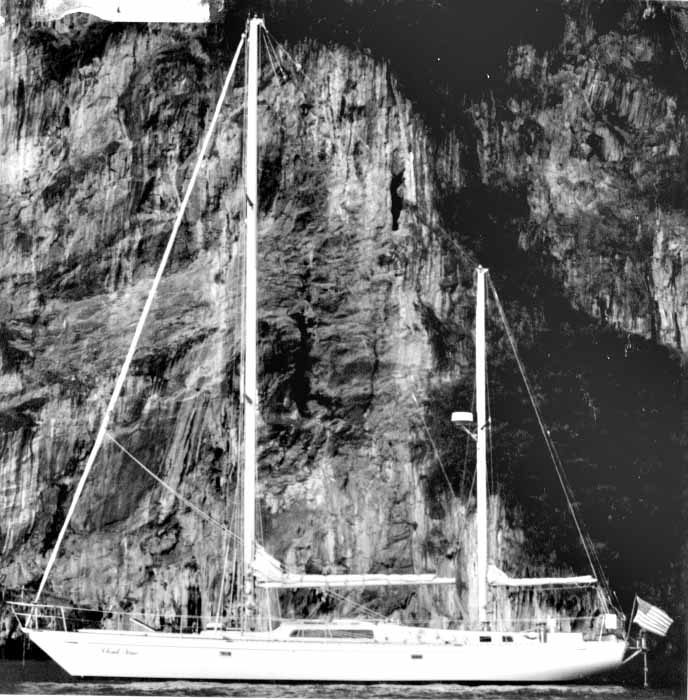
Christmas is that very special time of year when we need to take a little extra time to reflect on our faith, count our blessings, and ponder the important things in our lives. Not only our own lives, but those of our families and friends. Our travels aboard Cloud Nine make us aware of how fortunate we are to live as we do. As we face the problems of each day, it is important not to lose sight of the comforts and opportunities we have that are far beyond those of most people of the world.
Before launching into the Cloud Nine saga, I might once again suggest you lay this aside until you have a little time to wander with us in Southeast Asia.
On February 1st we left Minnesota and rejoined Cloud Nine in Phuket, Thailand, where we left her in the care of our crewmember, DiDi. You might recall I made a fast flight home from India last Novermber with a heart problem while Gaynelle and crew sailed 1500 miles from Cochin to Thailand without me. I'm not sure which episode caused me the greater anxiety, but fortunately all went well for both of us.
My health condition seems to be under control and we are continuing our cruising plans.
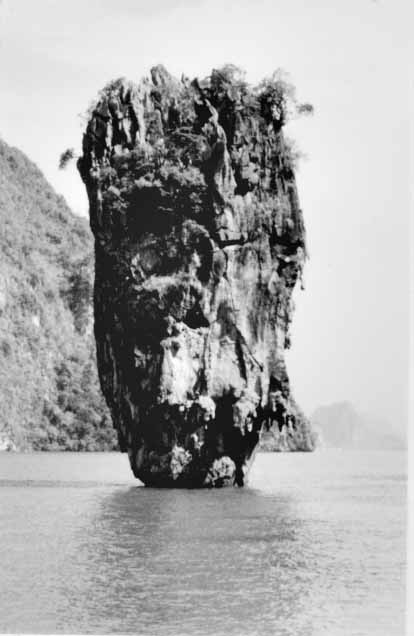 Cloud Nine has been in Phuket twice on previous trips and I consider it to be one of the outstanding cruising areas of the world. To take advantage of this, we spent several days with guest crews winding our way among the nearly vertical rock sentinels that jut from the surface of the waters of Phangnga Bay like clusters of Disney World castles. Many are riddled with hollows and caves which we explored by dinghy. In the photos, you may recognize the rocky pinnacle on which the evil Scaramanga placed his solar reflector in the James Bond film, "The Man with the Golden Gun."
Cloud Nine has been in Phuket twice on previous trips and I consider it to be one of the outstanding cruising areas of the world. To take advantage of this, we spent several days with guest crews winding our way among the nearly vertical rock sentinels that jut from the surface of the waters of Phangnga Bay like clusters of Disney World castles. Many are riddled with hollows and caves which we explored by dinghy. In the photos, you may recognize the rocky pinnacle on which the evil Scaramanga placed his solar reflector in the James Bond film, "The Man with the Golden Gun."
It was not possible to get a sailing permit to visit Burma (now called Myanmar) aboard Cloud Nine. Accordingly, we flew from Phuket to Rangoon (now Yangon) via Bangkok. Forgive me if I use the more familiar geographical names in this account.
Since obtaining its independence from England in 1948, Burma has had a history of almost continuous political and economic problems, but the heavy handed military government maintains order and remains in firm control. A democratic government was elected in 1990, but the military rulers refused to step down, resulting in a political stalemate. Although closed to tourism for a long time, the country has opened for visitors in recent years and four week visas are now available, giving relatively unrestricted travel throughout many areas of the country. A philosophical question remains as to whether tourist income will help further establish the restrictive military government or whether exposing the people of Burma to visitors from the outside world will eventually bring greater freedom.
We prefer to avoid the restrictions of organized tours and usually travel by ourselves, often with a guide. This gives us more freedom to wander off the wellworn tourist trails and allows closer contact with the people. Contrary to public opinion, we did not see an oppressed population in Burma.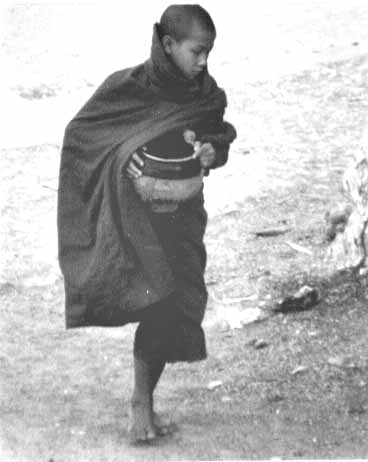
Our observations plus frequent converstaions with local people (generally through our guide, because of language differences) tended to indicate that nearly everyone was employed, had a place to live, and adequate food and clothing. Life is simple and living conditions are not luxurious, but the people appeared to be healthy and content. They were certainly open and friendly toward us. One person said, "Our government does a pretty good job of everything except politics," in reference to its bad reputation in the eyes of the world.
Burma is 87% Buddhist with temple stupas punctuating the city and country skylines. The stupa or pagoda (as it is often called) is usually a solid brick structure, normally built over a religious relic, in some cases a hair or bone fragment of the Buddha. The external surface of the structure is usually covered with gold, sometimes gold paint, but often heavy gold leaf. Each morning the monks go out to beg for food, as they are allowed to eat only what is given to them.
On the outskirts of Rangoon we visited a war cemetery containing the graves of 27,000 Allied dead. Most Americans are not aware of the bitter and prolonged fighting that went on against the Japanese in Burma. The majority of the dead were Indian and Burmese soldiers, but many British and some American graves are there also.
 We traveled inland about 250 miles, stopping at Inle Lake where the majority of the population of 70,000 people live in stilt houses on and around a large shallow lake area. They grow vegetable crops on floating islands made up of silt and vegetable matter that must be staked to the bottom with long bamboo poles to keep them from floating away. Fishermen skillfully balance on one leg as they maneuver their canoes using one arm and the other leg on the paddle giving them better visibility into the surprisingly clear water.
We traveled inland about 250 miles, stopping at Inle Lake where the majority of the population of 70,000 people live in stilt houses on and around a large shallow lake area. They grow vegetable crops on floating islands made up of silt and vegetable matter that must be staked to the bottom with long bamboo poles to keep them from floating away. Fishermen skillfully balance on one leg as they maneuver their canoes using one arm and the other leg on the paddle giving them better visibility into the surprisingly clear water.
Another 100 miles north brought us to Kipling's fabled Mandalay. It was the last capitol of Burma before the English took over in 1885, and remains the cultural and religious center of the country. Historically speaking, the Burmese were a fierce people and its past is an ongoing story of wars and conquests. Conquering rulers would establish new capitol cities, and we saw the ruins of several of these located near Mandalay. It is hard to understand Burma's bloody history as we visit with these seemingly kind and gentle people.
A day aboard a riverboat headed down the Irrawaddy River brought us to ancient Pagan (now called Bagan), the highlight of our visit to Burma. Over 3,000 temples and stupas have been found, many of them still in excellent condition, and all within a few miles of each other. Some restoration has been done, but many are untouched.
An extraordinary religious fervor created this unique collection of temples in only 250 years ending with the Mongol invasion in 1287 AD. If one could imagine all the medieval cathedrals of Europe having been built in one small area in a relatively short period of time, then deserted and left virtually untouched for 800 years, it might compare with Pagan. Marco Polo was so impressed with these temples that he described them in his famous 1298 chronicle as “one of the finest sights in the world."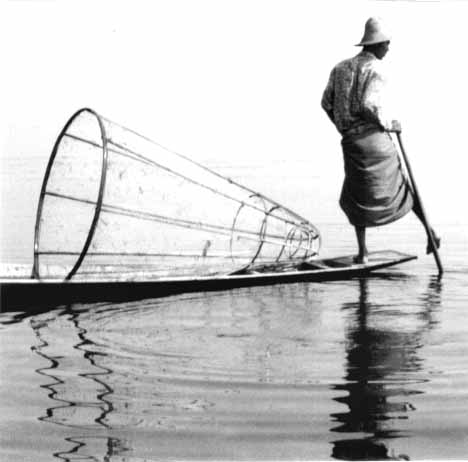
In one temple complex, the builders counted the bricks that went into the construction of a large temple by setting aside one brick, called a tally brick, for every 10,000 bricks that were used in construction. When finished, they built a sizeable secondary "tally temple" from the tally bricks! Speaking of measure, Burma is the only country we have found outside of the United States not using the metric system. They still use feet, inches, miles, and degrees fahrenheit. I suspect we Americans are too stubborn to change (thinking the rest of the world should follow us) and the Burmese don't yet realize the rest of the world has changed!
Reluctantly, we left this fascinating land and returned to Thailand where we explored the sights of Bangkok including the gaudy but interesting Grand Palace. However, we soon tired of the traffic nightmare of this chaotic city and flew to Chiang Mai in northern Thailand. Chiang Mai parallels Mandalay as the active religious and cultural center of Thailand, with over 300 temples and many traditional handicraft industries located here. Historically, it has seen many struggles, both with warring kingdoms in Thailand and also with Burma. The Burmese conquered this area twice, the first time in the 11th century and the second in 1556, when they stayed for 200 years before the Thais finally drove them out.
We went north to the hill tribe country near the Burma border where we trekked to several remote tribal villages. We remained overnight in an Akha village hut where they prepared dinner for us over an open fire inside the bamboo hut. We shuddered at the fire hazard, but the house didn't burn and the dinner was excellent. Grandpa was smoking opium in the far corner of the central room where we shared dinner with the Akha family. After a social time with some of the children in the village, we slept on the bamboo floor.
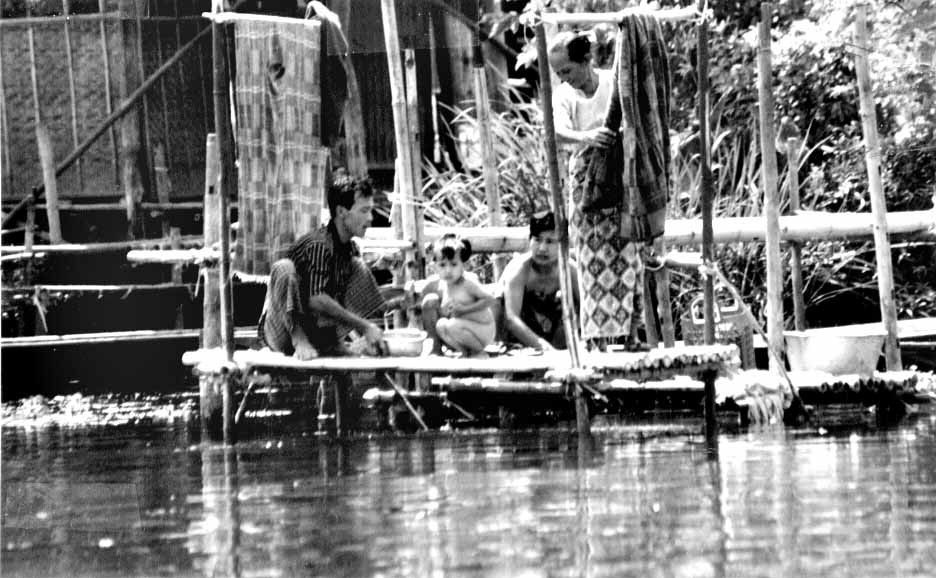 We drove to the Golden Triangle where Thailand, Burma and Laos meet at the junction of the Mekong and the Ruak Rivers. This is the largest opium producing area in the world, creating an illegal trade of unbelievable proportions. The Thai government attempts to restrict this trade, but it is estimated that less than 2% of the traffic is actually intercepted. Trekkers are warned not to wander outside the villages after dark because of the danger of accidentally stumbling into a dangerous and potentially fatal situation.
We drove to the Golden Triangle where Thailand, Burma and Laos meet at the junction of the Mekong and the Ruak Rivers. This is the largest opium producing area in the world, creating an illegal trade of unbelievable proportions. The Thai government attempts to restrict this trade, but it is estimated that less than 2% of the traffic is actually intercepted. Trekkers are warned not to wander outside the villages after dark because of the danger of accidentally stumbling into a dangerous and potentially fatal situation.
It was time to return to Cloud Nine at Phuket where our next sailing crew was assembling. After provisioning, we sailed south, stopping at the scenic Langkawi Island group in northern Malaysia. Langkawi has a booming tourist industry having been granted duty-free status by the Malaysian government. We were told this was an effort to lure travelers away from Pinang, which is primarily controlled by Chinese businessmen, a source of irritation to the Malaysian administration.
We continued down the west coast of Malaysia, stopping at various ports enroute. The Straits of Malacca, the narrow reef-strewn strip of water between Malysia and Sumatra, has been a pirate ambush point for over 1,000 years. The piracy continues today, but no longer seems to be a serious threat to small vessels such as ours. In recent years pirates have become more sophisticated and go after commercial ships which often carry large amounts of payroll money and cargo which can be sold in illegal markets.
This leg of our trip ended in Singapore, now the largest seaport in the world. This city never ceases to amaze me. In 1965, tiny Singapore Island, only 30 miles long, was expelled from Malaysia. With no organized government and not much of an economy, concerned people wondered how it could continue to exist. Now, only 34 years later, it is a model for the world, essentially a crime free, drug free, squeaky clean modern city with a thriving economy. Its downtown skyscrapers and modern shopping centers rival any in the world.
It was time to fly home to visit the family and reacquaint ourselves with our grandchildren, making for an enjoyable summer. Three short months later, on August 14, Gaynelle and I arrived back aboard Cloud Nine at Singapore in preparation for our trip through Indonesia. A Singapore highlight was a daysail in the harbor with my sister, Esther and part of her family, Martin, Bill and Jennifer. In all these years, Esther, had never seen Cloud Nine.
Indonesia, with its population of more than 200 million people, fourth largest in the world after China, India and the United States, is an incredibly diverse land consisting of over 13,000 islands scattered over 3,000 miles, from the Asian mainland to the Pacific Ocean. After my 1990 Indonesian cruise it has been high on my list for a return visit. However, the existing political situation did cause us to question our plans. Although too complex to discuss in detail here, the country has been in a state of turmoil since the fall of President Suharto about two years ago. The suffering of the people in the independence movement in East Timor has brought world criticism against the Indonesian government. A massive power struggle was underway for the presidency, which was to be decided in the election scheduled for October 20th. But, with our cruising permits and visas all in place, we decided to continue on with our plans, listening regularly to BBC news for political developments. We always kept Cloud Nine topped off with fuel and provisions, should it suddenly become necessary to run.
We entered Indonesia at the island of Batam just south of Singapore, one of the Riau Islands which are scattered like confetti over the South China Sea. Our next stop was Tanjung Pinang, capitol and administrative center of the Riau group where we immediately found ourselves immersed in Indonesia. This is a teeming, crowded city, which has maintained much of its old-time charm with picturesque sections of town built on stilts that jut over the sea. There were very few white faces on the streets, but people were friendly and helpful and we did not feel any hostility toward us. Not many spoke English, but DiDi's Indonesian is pretty good, and was a great help throughout our trip.
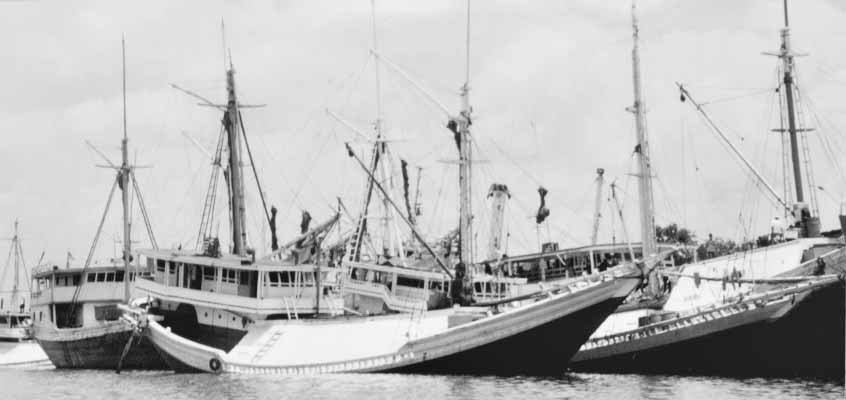 The harbor sees a constant stream of shipping of every shape and size, from tiny sampans to large freighters. Cloud Nine looked proud, but a little out of place, anchored in this profusion of old world craft.
The harbor sees a constant stream of shipping of every shape and size, from tiny sampans to large freighters. Cloud Nine looked proud, but a little out of place, anchored in this profusion of old world craft.
We made several stops at small islands, some of which were once the home of grand rajahs with great power and economic importance, but now little remains of their former glory except a few palace ruins and tombs. Silent reminders that nothing is forever!
We were often visited by dugout canoes filled with curious villagers. Many would ask to come aboard, but we found it necessary to limit this practice as they would come aboard and stay indefinitely, making it difficult to ask them to leave without being rude.
A five-day bash to windward against stronger than normal prevailing southeasterlies brought us to Kumai, a small city about 10 miles up the Kumai River in southwestern Kalimantan (Borneo), land of the Dyak headhunters. Much of Borneo is still relatively inaccessible, the rivers being the only avenues of transport in many areas.
The riverfront across from our anchorage was a scene right out of a Joseph Conrad novel. Countless wooden sailing craft of all sizes were moored along the shoreline. Many had no engines and had to enter and leave port on the tide, as they have been doing for hundreds of years. The larger vessels were over 100 feet long and in varying states of repair. Many were being loaded with teak logs that had been rafted together and floated down the river from the islands remote interior with little regard for Borneo's deforestation problems. Coastal trading vessels and fishing boats made up the rest of the craft.
 Here we experienced one of the year’s highlights. We left Cloud Nine and took passage aboard a local river boat accompanied by three natives, a guide, a captain/cook and a helper, for a three-day trip up a small tributary of the Kumai River. As we progressed upstream, the river narrowed and the trees almost closed overhead. We could imagine ourselves aboard the African Queen, and I was tempted to address Gaynelle as “Rosie, Old Girl.” Above us, we saw hundreds of rare proboscis monkeys, found only in Kalimantan. We saw birds totally unfamiliar to us and an occasional crocodile along the river bank.
Here we experienced one of the year’s highlights. We left Cloud Nine and took passage aboard a local river boat accompanied by three natives, a guide, a captain/cook and a helper, for a three-day trip up a small tributary of the Kumai River. As we progressed upstream, the river narrowed and the trees almost closed overhead. We could imagine ourselves aboard the African Queen, and I was tempted to address Gaynelle as “Rosie, Old Girl.” Above us, we saw hundreds of rare proboscis monkeys, found only in Kalimantan. We saw birds totally unfamiliar to us and an occasional crocodile along the river bank.
We were traveling in Tanjung Puting National Park which contains several primate sanctuaries. We moored to a small pier where we were met by a ranger and a young gibbon who approached Gaynelle and, much to her surprise, clamored up her clothes and into her arms. A few minutes later, while walking along a trail we met an adult orangutan carrying her baby. As you might imagine, we quickly stepped aside to let her pass. We visited three orangutan camps programmed for different age animals: infants, juveniles (age 6 to 11 years), and adults. Juvenile orangutans would take us by the hand and lead us down the trails while others would climb up and want to be carried. We were a bit apprehensive at first as they are incredibly strong (remember “The Murders in the Rue Morgue" by Edgar Allen Poe?), but the rangers were helpful and kept a careful watch over all that was happening. The orangutans are unbelievably graceful and move through the treetops as easily (and faster) than we could walk along the trail below. At night we slept on the riverboat under mosquito net,s listening to the strange and wonderful sounds of the jungle.
The orangutan (meaning man of the forest in Indonesian) is only found on Kalimantan and Sumatra and is in danger of extinction. The birth cycle is only about one young every eight years, some of whom are killed by natural predators. Natives sometimes kill adults if they consider them a nuisance. The purpose of these camps is to protect orphan orangs and prepare them for life in the wild. This project was started in the early 1970's and has been quite successful with the adult orangutans eventually wandering off into the jungle and sustaining themselves. However, some adults occasionally return to the camps and visit, especially during feeding times.
To be continued in the April issue.
Back to Articles
About Sailing Breezes Magazine
Please send us your comments!!
All contents
are copyright (c) 1999
by Northern Breezes, Inc. All information contained within is deemed reliable but carries
no guarantees. Reproduction of any part or whole of this publication in any form by
mechanical or electronic means, including information retrieval is prohibited except by
consent of the publisher.

 Cloud Nine has been in Phuket twice on previous trips and I consider it to be one of the outstanding cruising areas of the world. To take advantage of this, we spent several days with guest crews winding our way among the nearly vertical rock sentinels that jut from the surface of the waters of Phangnga Bay like clusters of Disney World castles. Many are riddled with hollows and caves which we explored by dinghy. In the photos, you may recognize the rocky pinnacle on which the evil Scaramanga placed his solar reflector in the James Bond film, "The Man with the Golden Gun."
Cloud Nine has been in Phuket twice on previous trips and I consider it to be one of the outstanding cruising areas of the world. To take advantage of this, we spent several days with guest crews winding our way among the nearly vertical rock sentinels that jut from the surface of the waters of Phangnga Bay like clusters of Disney World castles. Many are riddled with hollows and caves which we explored by dinghy. In the photos, you may recognize the rocky pinnacle on which the evil Scaramanga placed his solar reflector in the James Bond film, "The Man with the Golden Gun."
 We traveled inland about 250 miles, stopping at Inle Lake where the majority of the population of 70,000 people live in stilt houses on and around a large shallow lake area. They grow vegetable crops on floating islands made up of silt and vegetable matter that must be staked to the bottom with long bamboo poles to keep them from floating away. Fishermen skillfully balance on one leg as they maneuver their canoes using one arm and the other leg on the paddle giving them better visibility into the surprisingly clear water.
We traveled inland about 250 miles, stopping at Inle Lake where the majority of the population of 70,000 people live in stilt houses on and around a large shallow lake area. They grow vegetable crops on floating islands made up of silt and vegetable matter that must be staked to the bottom with long bamboo poles to keep them from floating away. Fishermen skillfully balance on one leg as they maneuver their canoes using one arm and the other leg on the paddle giving them better visibility into the surprisingly clear water.
 We drove to the Golden Triangle where Thailand, Burma and Laos meet at the junction of the Mekong and the Ruak Rivers. This is the largest opium producing area in the world, creating an illegal trade of unbelievable proportions. The Thai government attempts to restrict this trade, but it is estimated that less than 2% of the traffic is actually intercepted. Trekkers are warned not to wander outside the villages after dark because of the danger of accidentally stumbling into a dangerous and potentially fatal situation.
We drove to the Golden Triangle where Thailand, Burma and Laos meet at the junction of the Mekong and the Ruak Rivers. This is the largest opium producing area in the world, creating an illegal trade of unbelievable proportions. The Thai government attempts to restrict this trade, but it is estimated that less than 2% of the traffic is actually intercepted. Trekkers are warned not to wander outside the villages after dark because of the danger of accidentally stumbling into a dangerous and potentially fatal situation.
 The harbor sees a constant stream of shipping of every shape and size, from tiny sampans to large freighters. Cloud Nine looked proud, but a little out of place, anchored in this profusion of old world craft.
The harbor sees a constant stream of shipping of every shape and size, from tiny sampans to large freighters. Cloud Nine looked proud, but a little out of place, anchored in this profusion of old world craft.
 Here we experienced one of the year’s highlights. We left Cloud Nine and took passage aboard a local river boat accompanied by three natives, a guide, a captain/cook and a helper, for a three-day trip up a small tributary of the Kumai River. As we progressed upstream, the river narrowed and the trees almost closed overhead. We could imagine ourselves aboard the African Queen, and I was tempted to address Gaynelle as “Rosie, Old Girl.” Above us, we saw hundreds of rare proboscis monkeys, found only in Kalimantan. We saw birds totally unfamiliar to us and an occasional crocodile along the river bank.
Here we experienced one of the year’s highlights. We left Cloud Nine and took passage aboard a local river boat accompanied by three natives, a guide, a captain/cook and a helper, for a three-day trip up a small tributary of the Kumai River. As we progressed upstream, the river narrowed and the trees almost closed overhead. We could imagine ourselves aboard the African Queen, and I was tempted to address Gaynelle as “Rosie, Old Girl.” Above us, we saw hundreds of rare proboscis monkeys, found only in Kalimantan. We saw birds totally unfamiliar to us and an occasional crocodile along the river bank.